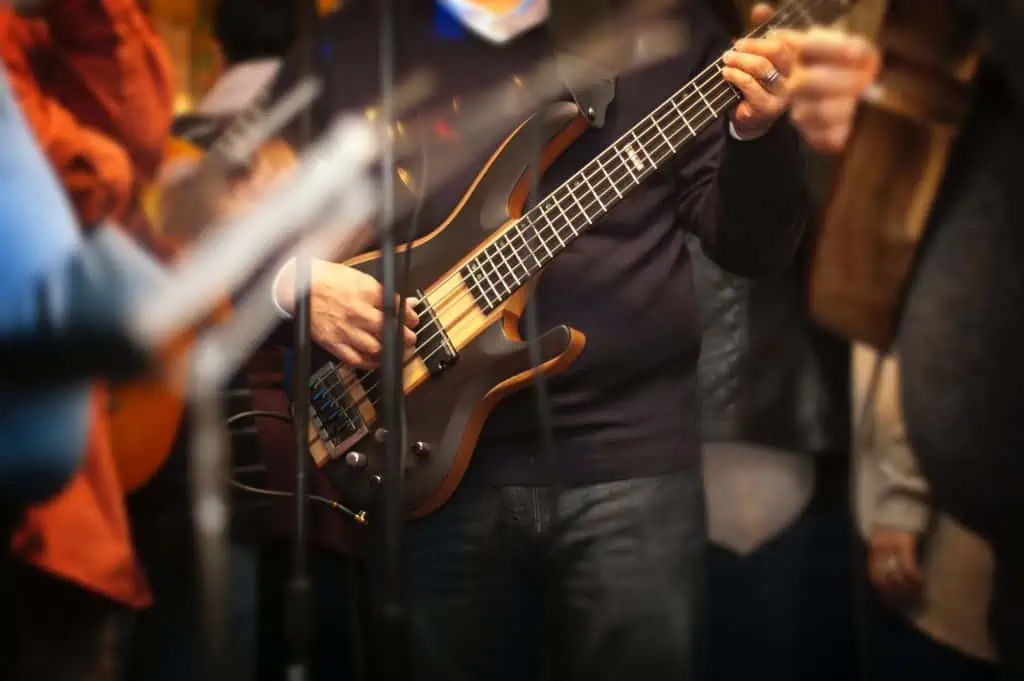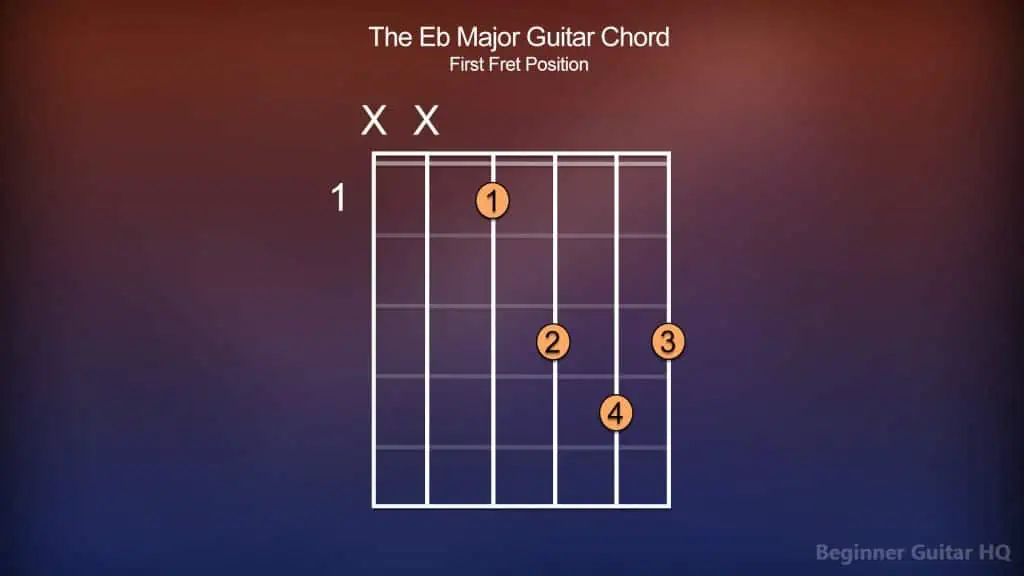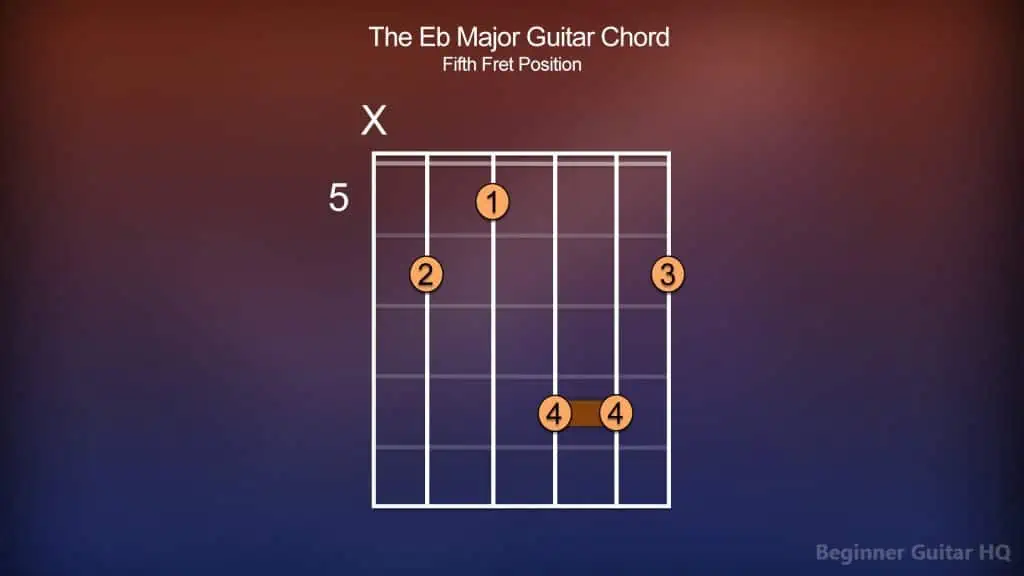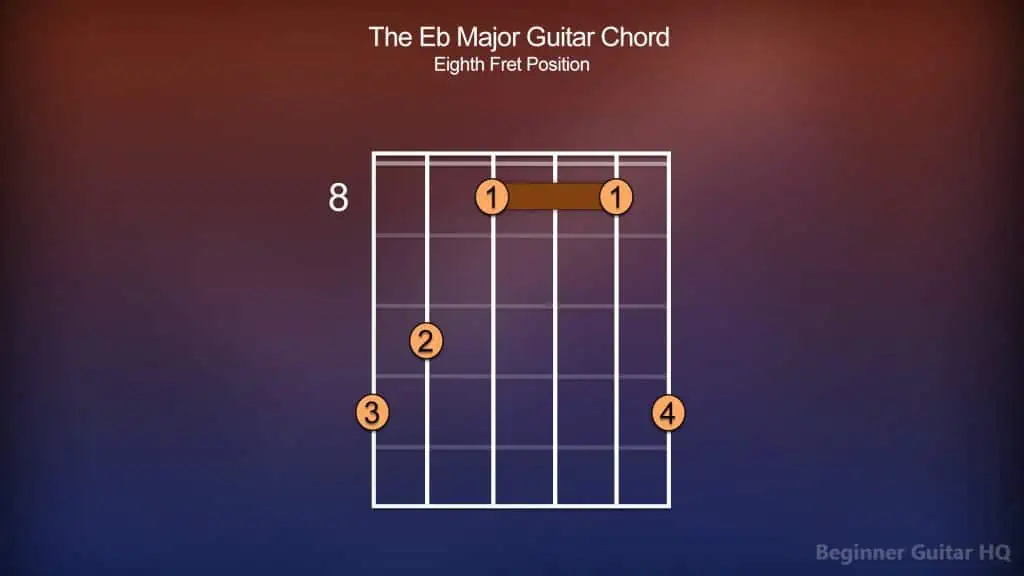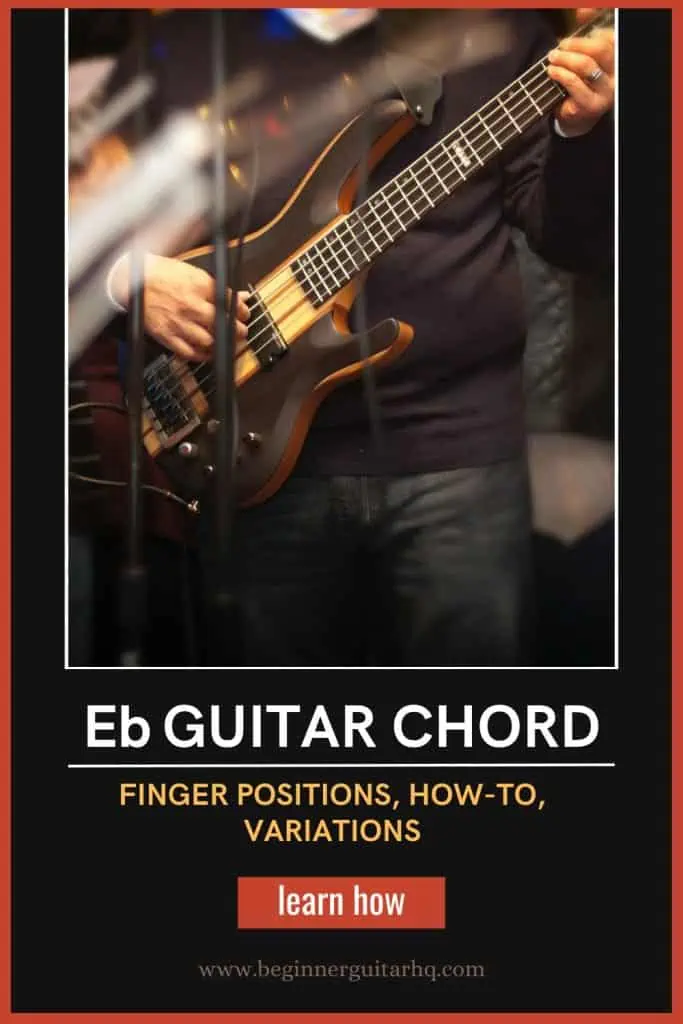The Eb chord is relatively simple, yet adds a slight challenge to beginner guitarists. In fact, this chord has been widely used across many popular hits, like “Weezer’s – Say It Ain’t So”, and “Queen’s – You Take My Breath Away”. Most often, however, you’ll find songs playing in Eb tuning, like “Guns N’ Roses – Sweet Child O’ Mine”, “Green Day’s – Basket Case”, and even “Lynyrd Skynyrd’s – Simple Man”. As you read on, we’ll cover how you can play this chord, and take a peek under the hood, to better understand how it works! Let’s dive in!
Contents
How to Play the Eb Chord
The Eb chord comes in a number of different variations. We can think of our chord variations as different placements and voicings for the notes within the chord, as you go up the neck. Variations offer something unique to stringed instruments like the guitar, and you may prefer to use one variation versus another, based on your playing ability, tonal qualities, fluidity, or a number of other reasons. For our Eb chord, we’ll cover six variations, which will vary in difficulty:
Chord chart of the Eb Major chord played from the open note position.
To start our Eb chord off, we’ll be playing from the first fret position. We can tell that it’s from the first fret, because of the number “1”, to the left of the chord chart. First, taking our index finger (1), we’ll place it over the first fret of the D string. Next, we’ll take our middle finger (2), placing it over the third fret of the G string. With our ring finger (3), we’ll be placing it over the third fret of the high E string. Finally, with our pinky finger (4), we’ll place it over the fourth fret of the B string. We’ll leave the low E and A strings muted, as we can see that they’re marked with an “X” above the strings.
From the D string to the high E string, let’s give our chord a nice strum. We’ve successfully completed our first variation of the Eb chord.
Chord chart of the Eb Major chord played from the third fret position.
We’ll start from the third fret position for our second variation. To kick things off, we’ll be forming a partial barre with our index finger (1). To achieve this, we’ll simply drape our index finger over the G, B, and high E strings, and apply pressure. There’s your partial barre! Next, let’s take our middle finger (2), and place it over the fourth fret of the B string. Following that, we’ll take our ring finger (3), placing it over the fifth fret of the D string. Finally, taking our pinky finger (4), we’ll place it over the sixth fret of the A string. We’ll leave the low E string muted.
Now, from the A string to the high E string, let’s give our guitar a nice strum! Our second variation is complete!
Chord chart of the Eb Major chord played from the fifth fret position.
For our third variation, we’ll begin forming our chord from the fifth fret. This chord will be a little trickier than the last two, so be patient with yourself!
First, taking our index finger (1), we’ll place it over the fifth fret of the D string. Next, with our middle finger (2), we’ll place it on the sixth fret of the A string. Following that, on the sixth fret again, we’ll be taking our ring finger (3), and placing it over the sixth fret of the high E string. Finally, we’ll be forming a partial barre with our pinky finger (4), over the eighth fret of the G and B strings. We’ll leave the low E string muted.
From the A string to the high E string, give a good strum; our third variation is complete!
Chord chart of the Eb Major chord played from the sixth fret position.
For the fourth chord variation, we’ll be starting from the sixth fret. To begin forming this chord, we’ll be taking our index finger (1), and forming a barre from the A string, to the high E string. Next, we’ll take our middle finger (2), placing it over the ninth fret of the D string. On the same fret, with our ring finger (3), we’ll place it over the G string. Finally, on the same fret again, with our pinky finger (4), we’ll place it over the B string.
Now, from the A string to the high E string, let’s give the guitar a strum. We’ve completed our fourth variation!
Chord chart of the Eb Major chord played from the eighth fret position.
For our fifth variation, we’ll be starting from the eighth fret. First, taking our index finger (1), we’ll form a partial barre over the D, G, and B strings. Next, taking our middle finger (2), we’ll place it over the tenth fret of the A string. With our ring finger (3), we’ll place it over the eleventh fret of the low E string. Finally, with our pinky finger (4), we’ll place it over the eleventh fret of the high E string.
From the low E string to the high E string, give the guitar a strum! We’ve successfully finished our fifth variation of the Eb chord.
Chord chart of the Eb Major chord played from the tenth fret position.
For the sixth and final variation, we’ll be forming our chord from the tenth fret position. First, we’ll take our index finger (1) and place it over the tenth fret of the A string. Next, on the eleventh fret, we’ll be taking our middle finger (2), and placing it over the low E string. Next, with our ring finger (3), we’ll place it over the eleventh fret of the B string. Lastly, with our pinky finger (4), we’ll place it over the eleventh fret of the high E string. We’ll leave the G string open, but keep the D string muted.
From the low E string to the high E string, let’s give the guitar a strum. There’s our final variation!
What is the Eb Chord?
The Eb chord can be better understood when it’s broken down into a few fundamental components, such as the key, scale, and the triad surrounding the chord. Let’s go through each of these in order.
Firstly, we have the key, which can be understood as the collective grouping of pitches you’d find in its corresponding scale. These pitches are defined by the key’s key signature. A key signature is often spotted next to the clef on a piece of sheet music, visually represented by a series of sharp (#) and flat (b) symbols. When a note is marked sharp, then it’s implied that the note is to be raised by a semitone. However, when a note is marked flat, it’s to be lowered by a semitone. Whether or not you’re new to the concept of key signatures, it can always help to refer to the circle of fifths for assistance. To save time, however, we’ll reveal that the key signature of Eb contains three flats, which are Bb, Eb, and Ab. With this information, we can now throw our Eb major scale together:
Eb > F > G > Ab > Bb > C > D > Eb
It’s important to note that each note in our Eb major scale plays an important role. We refer to these individual notes as our various scale degrees. Each scale degree, 1 – 7 is given a name, helping musicians refer to them with ease. Here are the various scale degrees within the Eb major scale:
Eb = Tonic (1st Degree)
F = Supertonic (2nd Degree)
G = Mediant (3rd Degree)
Ab = Subdominant (4th Degree)
Bb = Dominant (5th Degree)
C = Submediant (6th Degree)
D = Leading Tone (7th Degree)
Eb = Tonic (1st Degree/Octave)
Knowing our scale degrees is vital for things like building triads. A triad is a type of chord containing three notes, being played simultaneously. Major triads, like our Eb Major triad, are built on the foundation of our tonic, mediant, and dominant degrees of the scale (1st, 3rd, and 5th degrees). Within our Eb Major scale, this would give us the notes: Eb, G, and Bb, forming our Eb Major triad.
Let’s take this a step further, and look at the notes within our Eb Major triad. Forming the basis of our triad, are things called “intervals”, which can be understood as the gaps between two notes. Major triads contain very specific intervals between the notes within, giving it its characteristically happy sound:
- Major 3rd – Between the first and third degrees. Eb > G.
- Minor 3rd – Between the third and fifth degrees. G > Bb.
- Perfect 5th – Between the first and fifth degrees. Eb > Bb.
Compatible Chords
There is a method to make creating chord progressions a little easier; this involves the use of our newly learned triads. To start this method of finding chords compatible within the same key, we’ll be forming triads on each degree of the Eb Major scale:
Eb Major – Eb > G > Bb (Tonic/1st Degree)
F minor – F > Ab > C (Supertonic/2nd Degree)
G minor – G > Bb > D (Mediant/3rd Degree)
Ab Major – Ab > C > Eb (Subdominant/4th Degree)
Bb Major – Bb > D > F (Dominant/5th Degree)
C minor – C > Eb > G (Submediant/6th Degree)
D diminished – D > F > Ab (Leading Tone/7th Degree)
Now, let’s begin going into each of these degrees in a little more depth:
Tonic – This is our home, where things feel calm and tend to resolve. In this key, it’d be Eb.
Supertonic – Acts as a predominant degree, sharing two notes with the subdominant triad, Ab, and C. This degree applies some mild tension.
Mediant – Sharing two notes with our tonic triad, G and Bb, this degree is excellent for expanding off of the tonic, drawing it out.
Subdominant – A predominant degree, building mild tension, typically leading to the dominant degree.
Dominant – Typically the climax, the peak of our tension. This is one of our most important degrees, next to the tonic, where it’ll normally go to resolve afterward.
Submediant – Acts as a predominant degree, sharing two notes, not only with the tonic triad, Eb, and G, but the subdominant triad, C, and Eb.
Leading Tone – A degree holding great tension, as it falls right beneath the tonic, begging for resolution.
A good place to start when learning about scale degrees is to look at some of your favorite songs, or most successful hits you hear on the radio, dissecting how they work so well! You may even choose to use some of these tried and true chord progressions in your own music! Here are a couple of examples of chord progressions that work in the key of Eb Major:
I – IV – V
The one-four-five chord progression is one of the most common chord progressions, used across many popular hits, such as “Ozzy Osbourne’s – Crazy Train”, “The Beatles – Twist and Shout”, and even “Johnny Cash’s – Folsom Prison Blues”.
To play this chord progression in the key of Eb Major, we’ll begin on the tonic chord, the Eb Major chord. Next, we’ll shift to our subdominant chord, Ab Major, adding a little bit of tension. Following that, we’ll shift to the peak of our tension, Bb Major, before resolving home to Eb Major.
Our chord progression looks like this: Eb > Ab > Bb
I – vi – IV – V
This four-chord progression will start on the tonic, once again on the tonic, the Eb Major chord. Different, however, from our prior chord progression, we’ll instead be shifting to the submediant chord, C minor. Following that, we’ll move to the subdominant degree, playing the slightly tense Ab Major chord. Finally, we’ll move to the dominant degree, playing the Bb Major chord at the peak of our tension. Afterward, we’ll resolve home to the Eb Major chord.
Our chord progression looks like this: Eb > Cm > Ab > Bb
Eb to Ebm
When comparing the Eb Major chord to the Eb minor chord there are some important factors that create the overall difference in harmonies. The factors are none other than the difference in their keys, scales, and triads.
Beginning with the key of Ebm, we first need to understand the relationship it shares with Eb Major, being that of a “parallel key relationship”. This means that while both keys share the same tonic note (Eb), they contain different key signatures. This differs from the relationship Eb Major would share with C minor, where they contain different tonic notes, but share the same key signature.
So what is the key signature of Ebm? Looking at the circle of fifths, we can see that the key of Ebm contains six flats, which are Bb, Eb, Ab, Db, Gb, and Cb. Let’s throw our Ebm scale together!
Eb > F > Gb > Ab > Bb > Cb > Db > Eb
Within a Major scale, we have a set pattern of tones (T) and semitones (S) that follows: T > T > S > T > T > T > S. However, within a minor scale, this differs! Our sequence appears as:
T > S > T > T > S > T > T
Moving on, we need to form our minor triad in the key of Ebm. To achieve this, just as before, we’ll be taking the tonic, mediant, and dominant degrees of our scale (1st, 3rd, and 5th degrees), and stacking them on top of each other. This will give us the notes: Eb > Gb, and Bb, forming our Ebm triad.
Now, let’s talk a little more about the intervals within our Ebm triad, giving it its characteristically melancholy harmony:
- Minor 3rd – Between the first and third degrees. Eb > Gb.
- Major 3rd – Between the third and fifth degrees. Gb > Bb.
- Perfect 5th – Between the first and fifth degrees. Eb > Bb.
If there’s any difference to note between a minor triad and a major triad, simply look at the first interval in both; a minor triad will start with a minor interval, and a major triad will start with a major interval. However, the second interval will be the opposite, a major for a minor triad and a minor for a major triad. The perfect 5th will remain the same in both!
Let’s try playing our Eb minor chord now:
Chord chart of the Eb minor chord played from the first fret position.
To play the Ebm chord, we’ll begin from the first fret position. Let’s start by taking our index finger (1), and placing it over the D string. Next, we’ll take our ring finger (3), and place it over the third fret of the G string. Following that, with our pinky finger (4), we’ll place it over the fourth fret of the B string. Finally, with our middle finger (2), we’ll position it over the second fret of the high E string. We’ll leave the low E and A strings muted.
From the D string to the high E string, we’ll give the guitar a nice strum. We’ve successfully played our Eb minor chord!
Other Eb Chords
We’ve learned how to play the Eb and Ebm chords, however, why stop there? There are plenty of other Eb chords you may wish to learn next! Let’s briefly go through a couple:
Eb dim – The Eb dim chord contains your standard triad of notes on the tonic, mediant, and dominant degrees, except the dominant degree, is flattened! This gives us the notes Eb, Gb, and Bbb forming our Eb diminished chord.
To start playing the Eb dim chord, we’ll start on the first fret, placing our index finger over the D string. Next, with our middle finger, we’ll place it over the second fret of the G string. Now, we’ll position our pinky finger over the fourth fret of the B string. Finally, using our ring finger, we’ll place it over the second fret of the high E string. The low E and A strings remain muted. From the D string to the high E string, let’s give the guitar a strum.
EbSus4th – The Eb suspended fourth chord is formed from a slightly different triad than our standard major and minor triads. While those triads use the tonic, mediant, and dominant degrees, our suspended fourth chords use the tonic, subdominant, and dominant degrees. This gives our EbSus4th chord the notes: Eb, Ab, and Bb.
In order for us to play the EbSus4th chord, we’ll be starting from the first fret position. First, taking our index finger, we’ll place it over the first fret of the D string. Next, with our ring finger, we’ll place it over the third fret of the G string. Finally, we’ll be moving to the fourth fret, taking our pinky finger, and forming a partial barre over the B and high E strings. The low E and A strings will remain muted. From the D string to the high E string, we’ll strum the guitar.
Eb Major 7th – Our Eb Major seventh chord, unlike our aforementioned chords, contains four notes! It contains our base Eb major triad of notes: Eb, G, and Bb with the inclusion of a Major 7th, the note D, stacked on top!
To play our EbMaj7th chord, we’ll be starting from the first fret position. First, we’ll take our index finger and place it over the D string. Next, we’ll be moving to the third fret, and using our middle we’ll be placing it on the G string. Following that, on that same fret, we’ll take our ring finger, and place it on the B string. Finally, with our pinky finger on the same fret, we’ll place it over the high E string. The low E and A strings remain muted. From the D string to the high E string, give it a strum.
Conclusion
That’s all there is to it! This chord offers much in the way of challenge, allowing you to try your hand at more advanced chords as you build more strength and muscle memory. Perhaps you might even choose to take things a step further, trying the different chord formations in Eb tuning. The world is your oyster!

